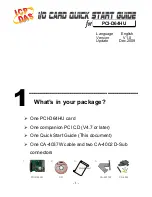
HARDWARE PROGRAMMING OF ADDITIONAL MODULE PUSH-BUT-
TONS
The dip-switches modify the hardware code of the first pushbutton at the
top right of the module, while the other push-buttons are associated con-
secutively from top t bottom, right to left (see Tables 1 and 2). Take care not
to overlap the codes of push-buttons on the same panel. When using the
modules with push-buttons in single or double rows the parameter “Sin-
gle/Double push-buttons” must be programmed according to the type of
module (see standard or advanced programming pages 15 and pages 16).
Fig. 14
PUSHBUTTON HARDWARE PROGRAMMING
(Perform modifications with system switched off)
The hardware programming of push-buttons enables the assignment of a
unique hardware identification code to each pushbutton of the panel. This
operation is indispensable to distinguish each button of the panel and
should only be performed for additional module 805x and 804x. The keys
on the standard modules are already assigned with the numbers from 1 to
8 and the relative hardware programming is not modifiable.
To associate the hardware code use the dip-switches in each additional
module below the white protection of the push-buttons. On 805x series
modules, with push-buttons in single rows, there are 6 dip-switches, while
the 804x series modules, with push-buttons in double rows, there are 5
dip-switches.
ON
1 2 3
ON
1 2 3
5
6
7
ON
1 2 3
ON
1 2 3
8
ID ENTRANCE PANEL, IDENTIFICATION PANEL CODE
The identification panel code is required when there is more than one
entrance panel on the installation and only for the panels previously
identified as SLAVE. The operation must be carried out after connecting
all the entrance panels, carrying out the previous operations and powe-
ring the installation.
Attention: if the installation power supplies are connected to the elctri-
cal network with more switchers, when switching the installation on, first
power the SLAVE entrance panels and then the MASTER entrance
panel.
Programming may be carried out by means of the programmer type
950C or the PC Software PC SaveProg or by push-buttons from the
entrance panels; if the entrance panel push-buttons are used it is neces-
sary have in the panel a number of push-buttons (different for the phy-
sical code) equal to the number of SLAVE entrance panels.
For example:
1) in an installation with 9 entrance panels (1 Master and 8 Slaves) 8 diffe-
rent push-buttons for the 8 entrance panels, provided with the electro-
nic unit.
2) in an installation with 11 entrance panels (1 Master and 10 Slaves) at
least 2 entrance panels out of 11 must be equipped with additional mo-
dules to have, besides the 8 standard push-buttons, other 2 push-
bttons with different physical codes.
Panel ID programming procedure
Perform the following procedure for each of the SLAVE panels.
- Power up the system. Power first the SLAVE panels followed by the
MASTER panel.
-
Wait until the red LEDs indicating ENGAGED/WAIT stop flashing.
-
Press and hold the RESET pushbutton (see page 2), of the electronic
unit.
-
Press and hold 1st pushbutton at the top right of the electronic unit to-
gether with the RESET pushbutton.
-
Release the RESET pushbutton while keeping pushbutton (top-right)
for 2 seconds.
-
Wait for the panel to emit a high tone from the loudspeaker.
-
Enter the Password by pressing the call push-buttons 6 - 5 - 4 - 3 - 2
- 1 in sequence. Each time a pushbutton is pressed, a short “Beep” is
sounded and the output time is renewed (25 seconds), until the next
pushbutton is pressed. The password can only be changed by means
of the programmer type 950C or the PC Software PC SaveProg.
-
If the password is correct, the panel emits a high tone of confirmation,
otherwise it emits a low tone and exits the programming phase. The
unit also exits the programming phase when the output time interval
elapses.
-
Within 25 seconds, press one of push-buttons to assign the identifica-
tion code to the SLAVE panel. Pushbutton (top-right) corresponds to
panel 1 SLAVE (ID=2), pushbutton n°2 under n°1 to panel 2 SLAVE
(ID=3) and so on.
If the identification code has already been assigned, the panel emits a long
high tone until another pushbutton is pressed. If the code is available, the
panel emits a low tone and exits the programming phase.
Fig. 13C
Caution!
In order to operate on the programming (PRG) and
Reset push-buttons it is necessary to use the proper
tool usually supplied with the electronic unit.
GB
10











































